A high-resolution morphological and ultrastructural map of anterior sensory cilia and glia in Caenorhabditis elegans
- PMID: 24668170
- PMCID: PMC3965213
- DOI: 10.7554/eLife.01948
A high-resolution morphological and ultrastructural map of anterior sensory cilia and glia in Caenorhabditis elegans
Abstract
Many primary sensory cilia exhibit unique architectures that are critical for transduction of specific sensory stimuli. Although basic ciliogenic mechanisms are well described, how complex ciliary structures are generated remains unclear. Seminal work performed several decades ago provided an initial but incomplete description of diverse sensory cilia morphologies in C. elegans. To begin to explore the mechanisms that generate these remarkably complex structures, we have taken advantage of advances in electron microscopy and tomography, and reconstructed three-dimensional structures of fifty of sixty sensory cilia in the C. elegans adult hermaphrodite at high resolution. We characterize novel axonemal microtubule organization patterns, clarify structural features at the ciliary base, describe new aspects of cilia-glia interactions, and identify structures suggesting novel mechanisms of ciliary protein trafficking. This complete ultrastructural description of diverse cilia in C. elegans provides the foundation for investigations into underlying ciliogenic pathways, as well as contributions of defined ciliary structures to specific neuronal functions. DOI: http://dx.doi.org/10.7554/eLife.01948.001.
Keywords: cilia; electron microscopy; electron tomography.
Conflict of interest statement
The authors declare that no competing interests exist.
Figures
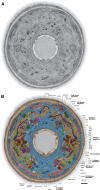

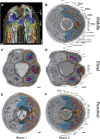
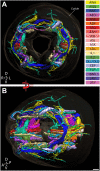
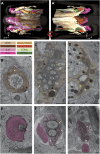


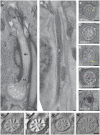
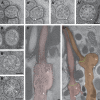
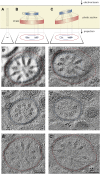




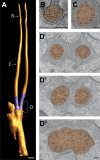






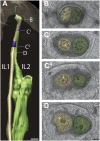
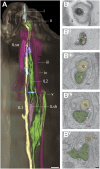


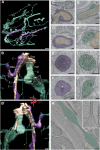
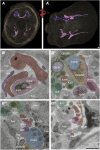
Comment in
-
Tomography gives a new dimension to an ancient organelle.Elife. 2014 Mar 25;3:e02589. doi: 10.7554/eLife.02589. Elife. 2014. PMID: 24668175 Free PMC article.
Similar articles
-
Tomography gives a new dimension to an ancient organelle.Elife. 2014 Mar 25;3:e02589. doi: 10.7554/eLife.02589. Elife. 2014. PMID: 24668175 Free PMC article.
-
Ultrastructural analysis of Caenorhabditis elegans cilia.Methods Cell Biol. 2015;129:341-367. doi: 10.1016/bs.mcb.2015.03.014. Epub 2015 May 27. Methods Cell Biol. 2015. PMID: 26175447
-
Image analysis of Caenorhabditis elegans ciliary transition zone structure, ultrastructure, molecular composition, and function.Methods Cell Biol. 2015;127:323-47. doi: 10.1016/bs.mcb.2015.01.010. Epub 2015 Mar 7. Methods Cell Biol. 2015. PMID: 25837399
-
Structural diversity in a stereotypic organelle - Sensory cilia of Caenorhabditis elegans.J Cell Physiol. 2022 Jun;237(6):2668-2672. doi: 10.1002/jcp.30732. Epub 2022 Jun 10. J Cell Physiol. 2022. PMID: 35686462 Review.
-
Applications of emerging transmission electron microscopy technology in PCD research and diagnosis.Ultrastruct Pathol. 2017 Nov-Dec;41(6):408-414. doi: 10.1080/01913123.2017.1365789. Epub 2017 Sep 18. Ultrastruct Pathol. 2017. PMID: 28922052 Review.
Cited by
-
Differential regulation of transition zone and centriole proteins contributes to ciliary base diversity.Nat Cell Biol. 2018 Aug;20(8):928-941. doi: 10.1038/s41556-018-0132-1. Epub 2018 Jul 16. Nat Cell Biol. 2018. PMID: 30013109
-
How Caenorhabditis elegans Senses Mechanical Stress, Temperature, and Other Physical Stimuli.Genetics. 2019 May;212(1):25-51. doi: 10.1534/genetics.118.300241. Genetics. 2019. PMID: 31053616 Free PMC article. Review.
-
Ciliopathy proteins establish a bipartite signaling compartment in a C. elegans thermosensory neuron.J Cell Sci. 2014 Dec 15;127(Pt 24):5317-30. doi: 10.1242/jcs.157610. Epub 2014 Oct 21. J Cell Sci. 2014. PMID: 25335890 Free PMC article.
-
How the Ciliary Membrane Is Organized Inside-Out to Communicate Outside-In.Curr Biol. 2018 Apr 23;28(8):R421-R434. doi: 10.1016/j.cub.2018.03.010. Curr Biol. 2018. PMID: 29689227 Free PMC article. Review.
-
Compartments within a compartment: what C. elegans can tell us about ciliary subdomain composition, biogenesis, function, and disease.Organogenesis. 2014 Jan 1;10(1):126-37. doi: 10.4161/org.28830. Epub 2014 Apr 14. Organogenesis. 2014. PMID: 24732235 Free PMC article. Review.
References
Publication types
MeSH terms
Grants and funding
LinkOut - more resources
Full Text Sources
Other Literature Sources

